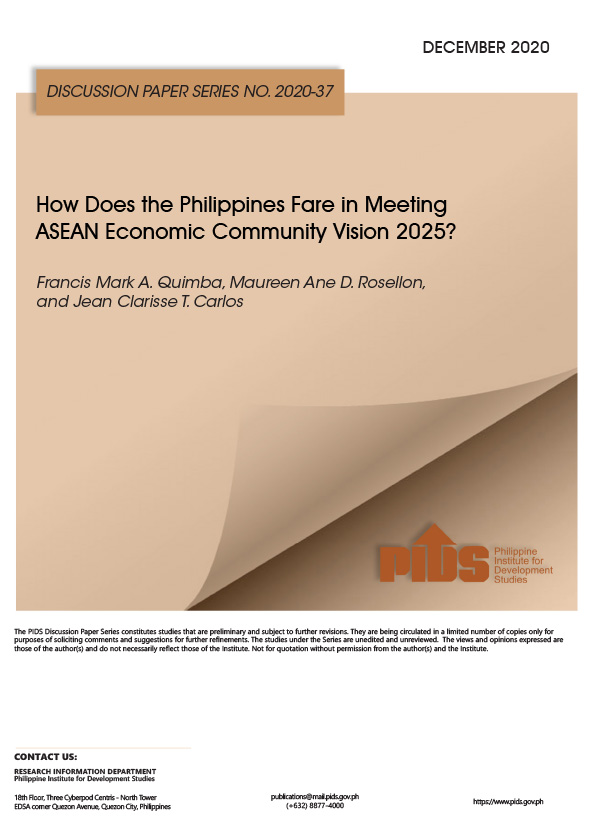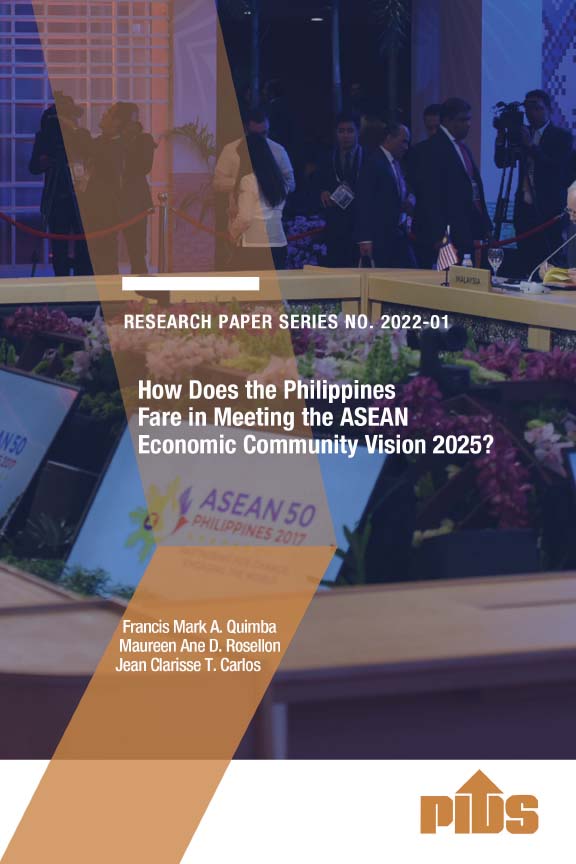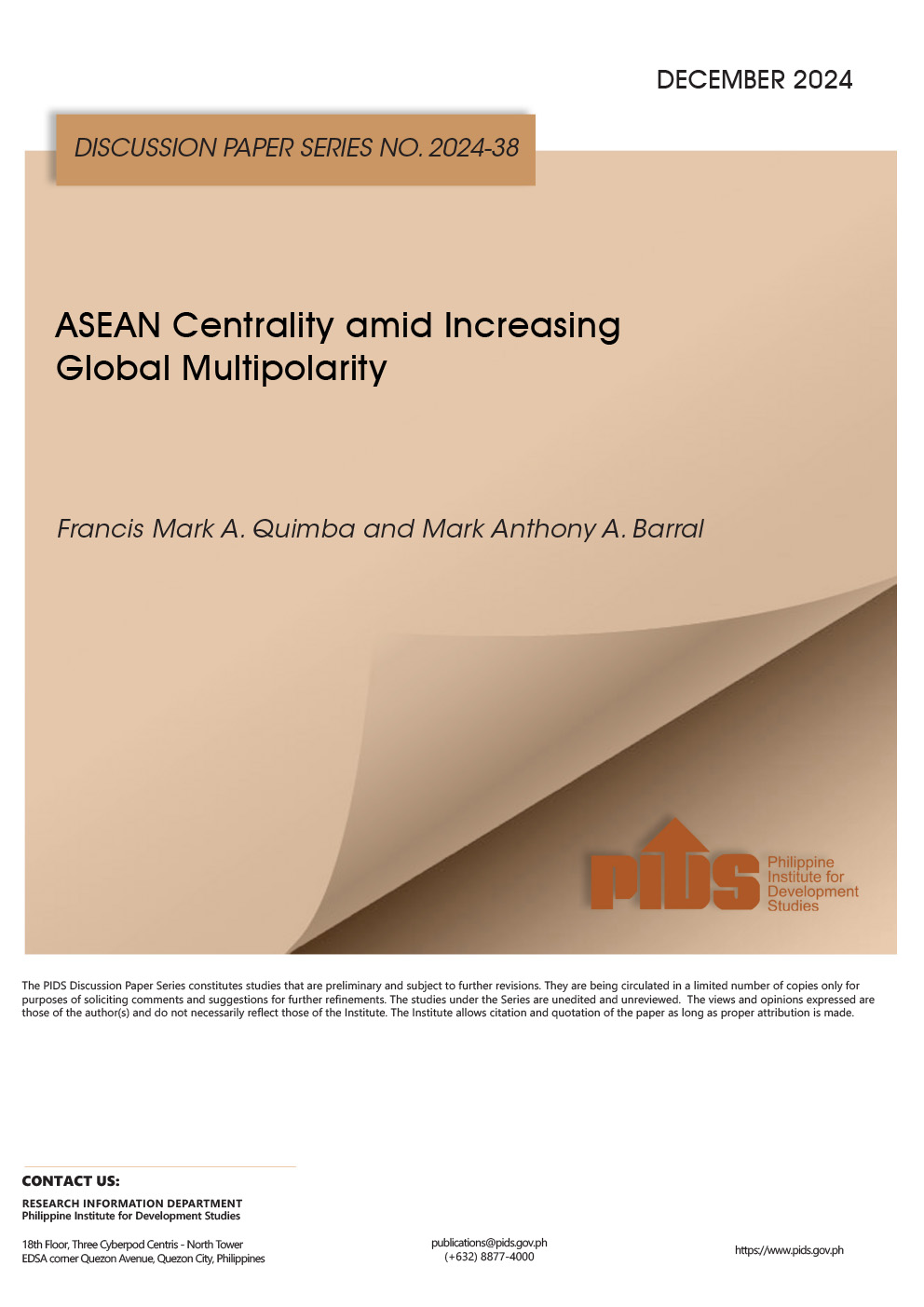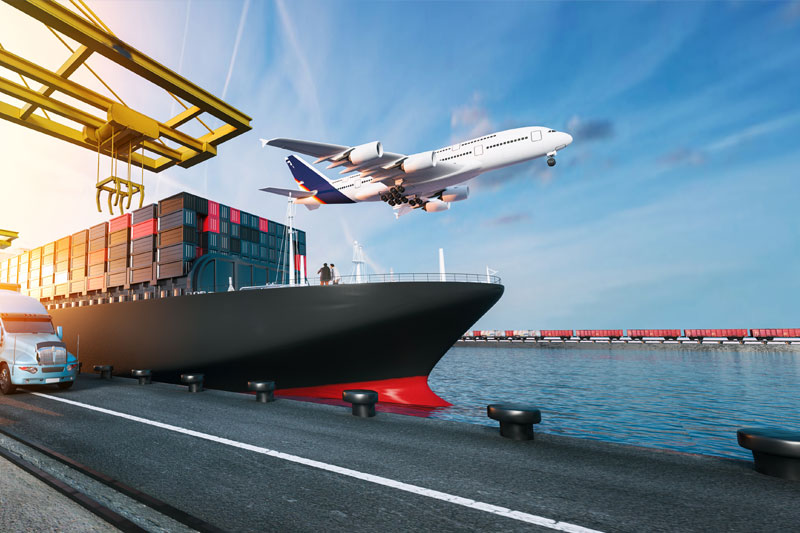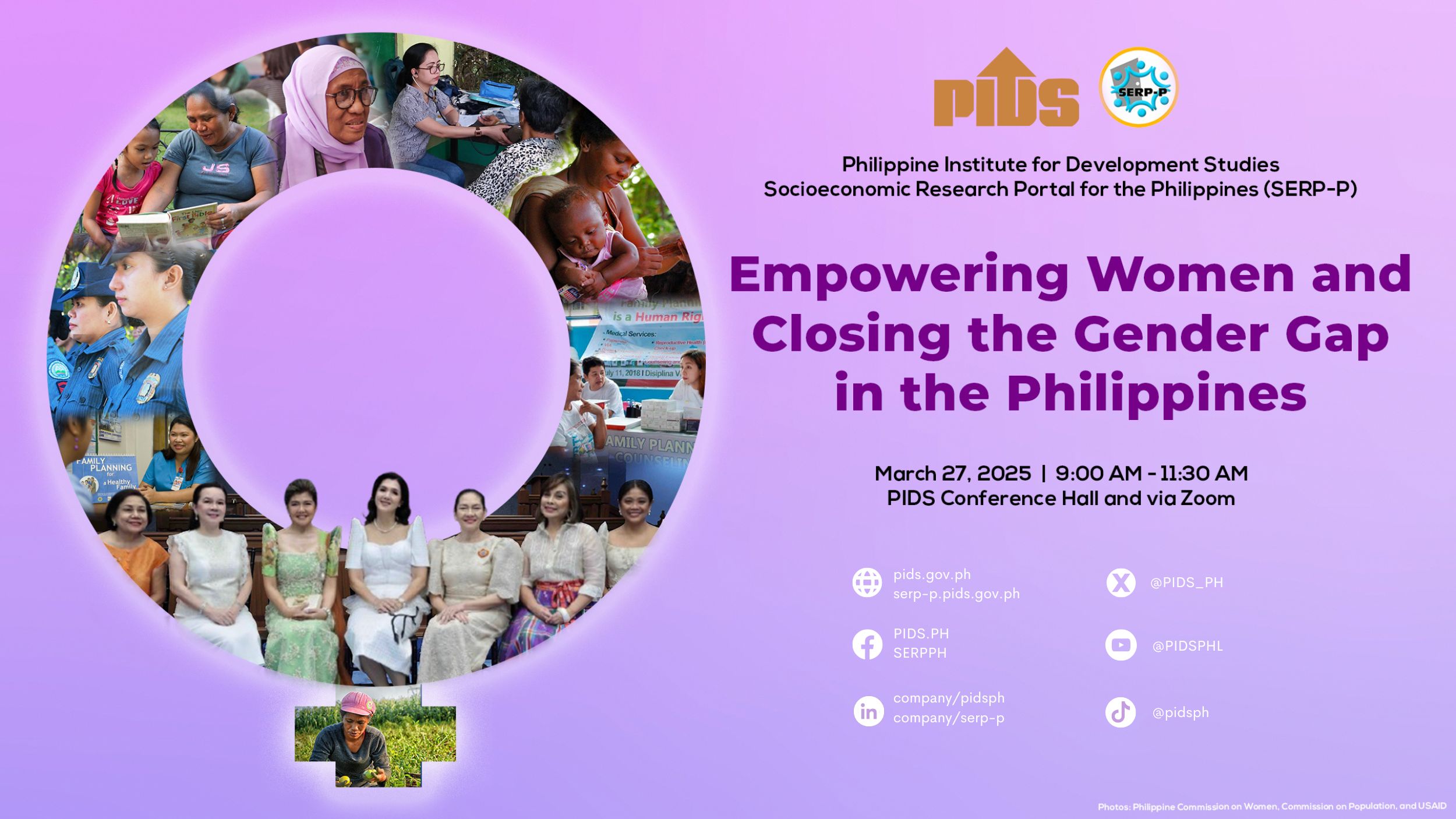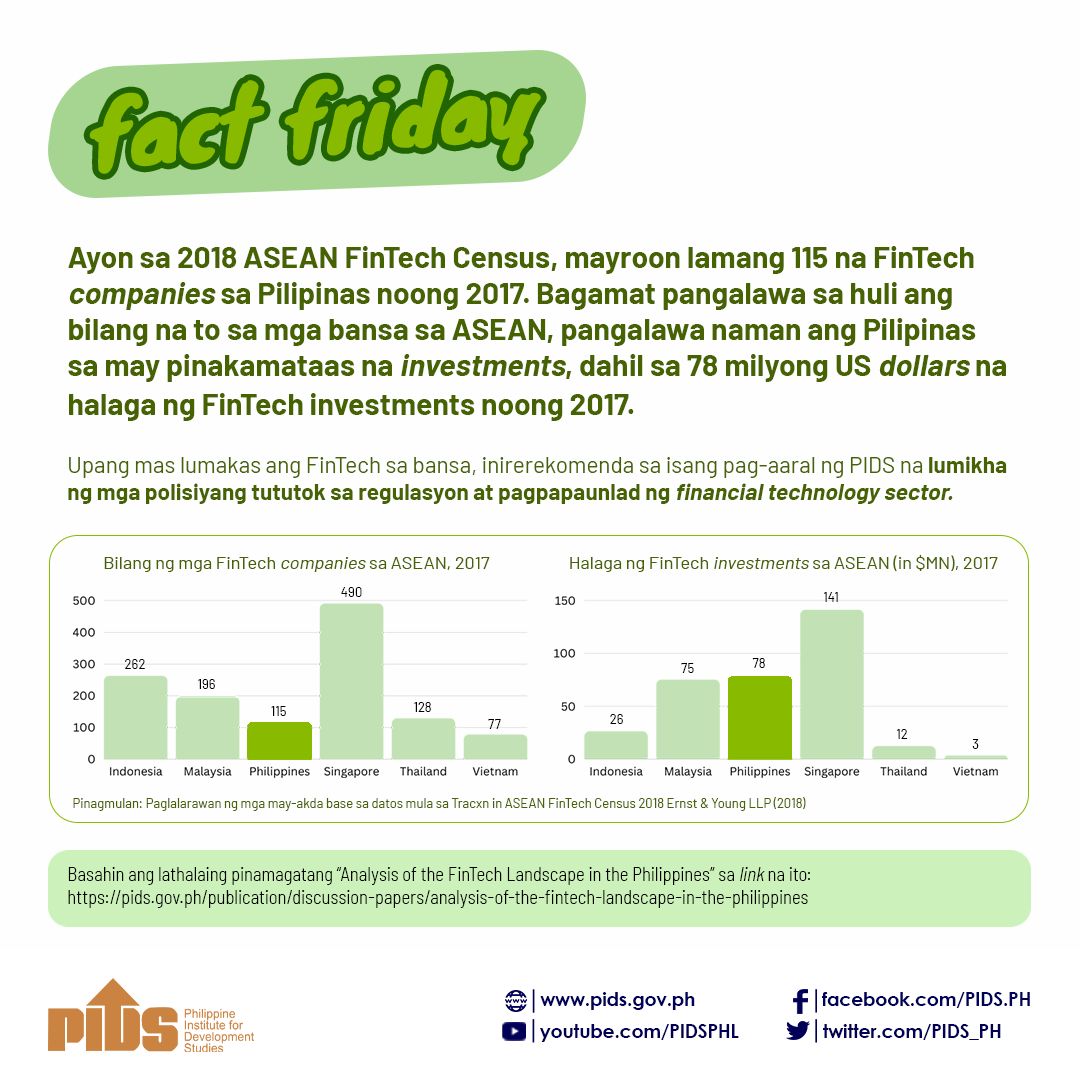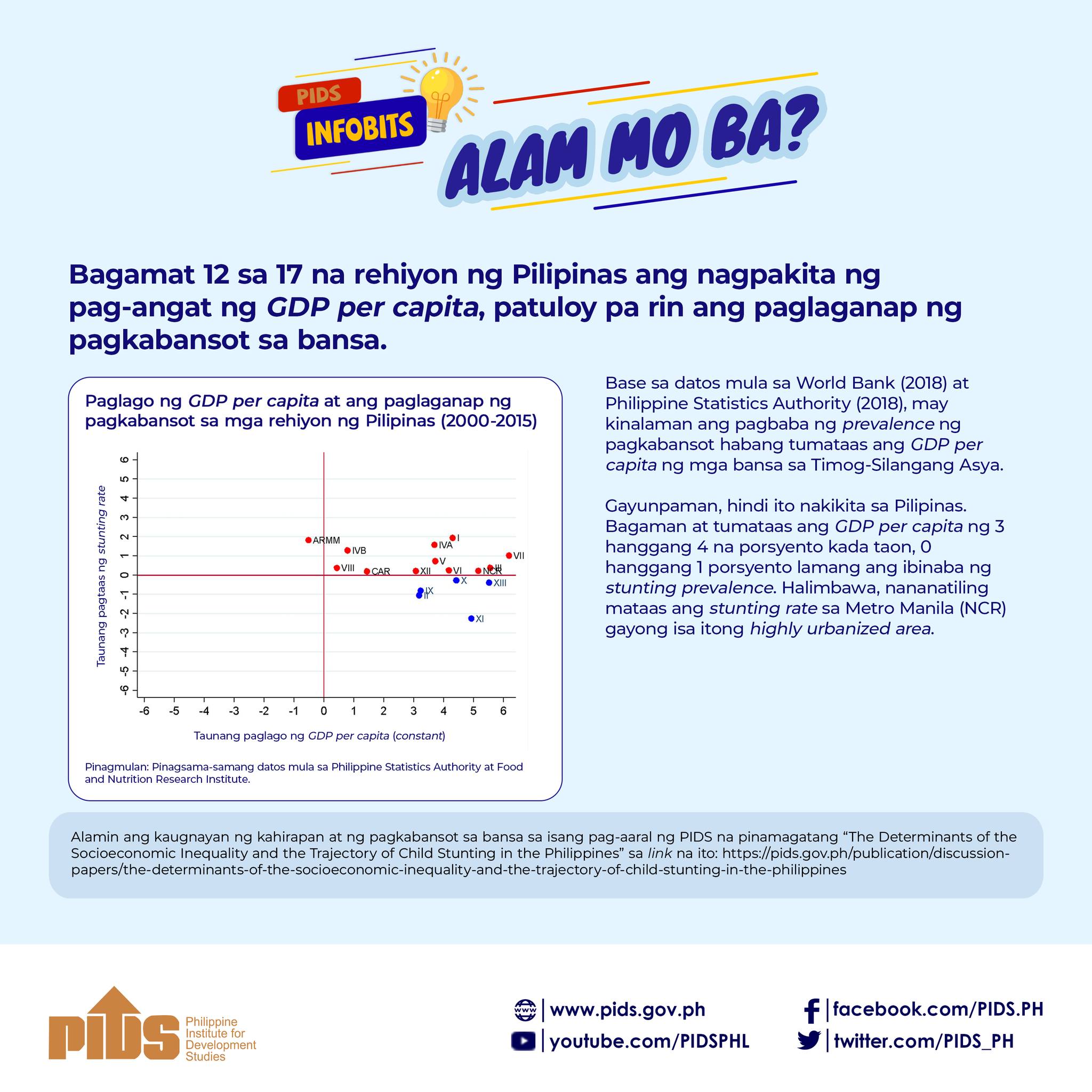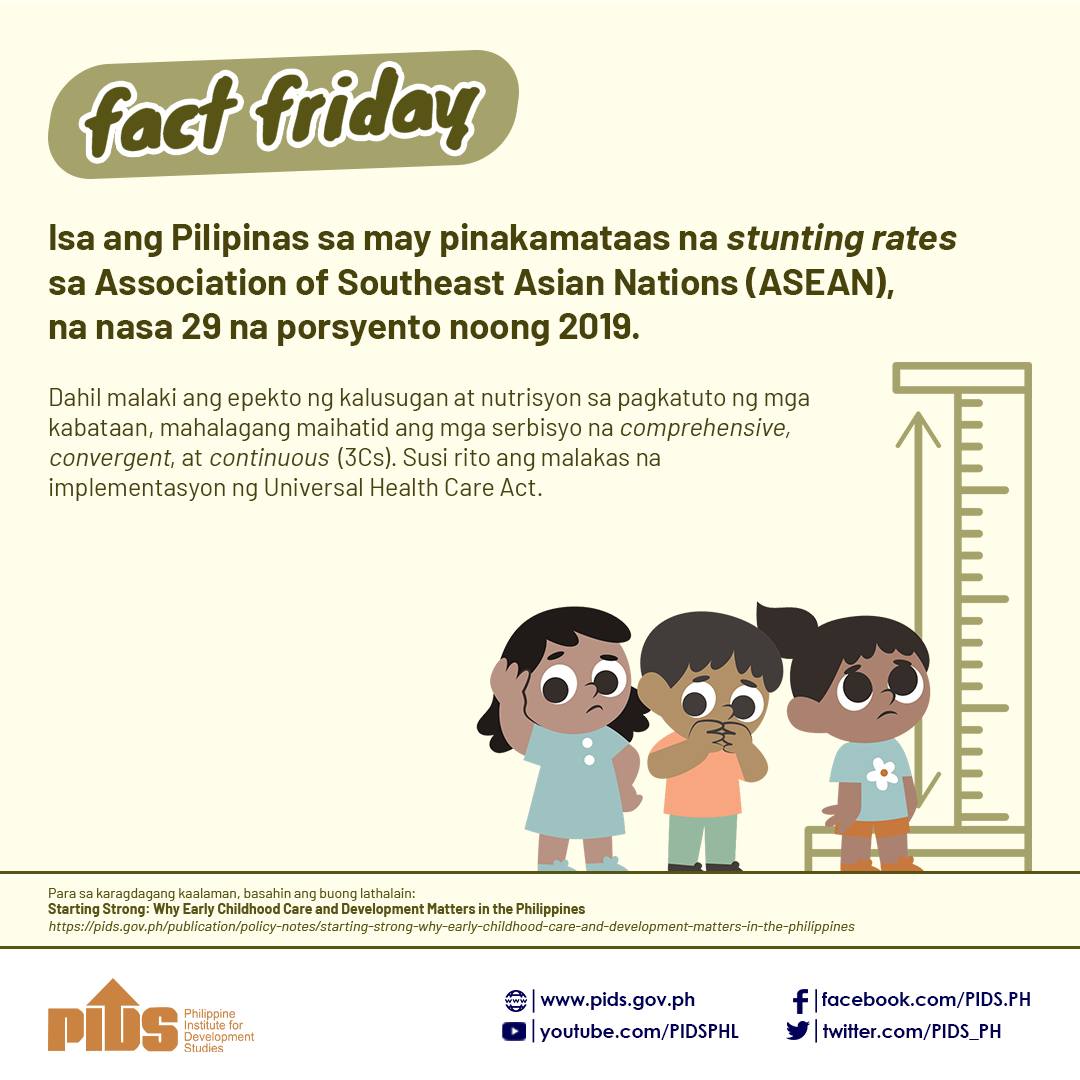
The Philippines' financial sector has a lot of catching to do to improve its competitiveness and be at par with the frontrunners of the Association of Southeast Asian Nations (ASEAN). Improved financial education and financial literacy, and reform policies to strengthen financial inclusion of small and medium enterprises (SMEs) should be at the heart of policy reforms to achieve the critical improvements necessary to gear up for the ASEAN Economic Community.
These were expressed by former PIDS president, Dr. Mario B. Lamberte, and his research associate, Ms. Ammielou Q. Gaduena, in their report on the country's financial system titled "Enhancing Access to Financial Services through a More Competitive Financial System", a component study of the Advancing Philippine Competitiveness (COMPETE) project funded by the United States Agency for International Development. The authors presented the study in a PIDS Pulong Saliksikan held on June 17 in Makati City.
Their research examined the role and contribution of banking, insurance and capital markets to the economy. It also gauged the competitiveness of the country's financial system compared with that of its neighboring ASEAN countries. In many of the indicators they used, the Philippines’ performance proved mediocre, if not dismal.
Lagging Behind
The authors forewarned that if the country is unable to render its financial sector with the proper reforms and policies to become more competitive, the Philippines will be disadvantaged when it becomes financially integrated with the rest of the ASEAN.
Foreign equity or the participation of foreign players in the financial sector is part of the country's commitments to the ASEAN Financial Agreement on Services. Although the Philippine`s foreign equity cap is not yet reflected in the commitments compliance report, Lamberte and Gaduena nonetheless noted that the banks of other ASEAN member-states (AMS) have a lot of room to "expand their presence in the Philippines in the near term, while it remains a big challenge for Philippine banks to penetrate the banking markets in other AMS."
In the capital markets, the Philippines has the most restrictive commitments in terms of foreign equity cap for investment houses, requiring that the board of directors must be fifty-one percent Filipino nationals. Philippine banks also show a consistency in coming second to the last when it comes to cost and profit efficiency.
Access to Credit
Access to credit in the country is much more restricted compared with that of its neighbors. Out of nine countries, the Philippines is only ahead of Myanmar, currently at the bottom of the list. Meanwhile, Malaysia, Thailand, Vietnam and Singapore consecutively sit at the top of at the nine ASEAN nations` ranking. Basically, this means the Philippine banks are not turning the money deposited by their customers into actual loans. The authors hypothesize that Philippine banks are discouraged from looking for qualified borrowers, especially among SMEs, because of high intermediation tax and high reserve requirements on deposits.
Established in 2012, the COMPETE project was created to help the Philippines improve its level of competitiveness by providing relevant sectors with technical assistance. The project covers strengthening public-private partnership programs in the infrastructure sector and supporting reforms that would promote the ease of doing business. In the aspect of financial services, COMPETE’s priorities are in helping SMEs access credit by improving the credit information system and strengthening the entrepreneurs' borrowing capacity.
Lamberte explained that SMEs are disadvantaged from acquiring or accessing credit because of many restrictive laws that hinder both SMEs and the banks or lending institutions. COMPETE helps small businesses overcome these hurdles. But Lamberte underscored that the key goal is to use the newly established credit information system to that end. A comprehensive and centralized credit information system will benefit SMEs by providing them with concrete know-how to access credit. At the same time, it will provide banks with profiles of viable business investments in SMEs across the country.
Recommendations
The authors believe that reducing intermediate taxes or reserve ratios will incentivize and enable the banking system to perform its financial intermediation function much better. Implementing policy reforms to encourage opening up to foreign players especially in the insurance and capital markets would facilitate further liberalization. Supporting a stronger merger and consolidation policy would also help.
But at the heart of it, support for increasing the competitiveness of SMEs should be duly realized. SMEs make up 90 percent of the country’s business sector. It is difficult for them to gain capital in general and they often rely on informal sources.
A handful of experts and professionals from the sector who were in attendance agreed that a stronger financial support for guarantee institutions would incentivize banks to get more involved in broadening credit access to SMEs.
Lamberte advised that this must coincide with the complete removal of special deposit accounts (SDAs). He said that most banks are not aware that there are many viable enterprises around, but they have no incentive to find out. If the Banko Sentral shuts down the SDAs, this might cure the general complacency of banks and encourage them to reach out to SMEs more.
Ambassador Jesus Tambunting, chair of the Small Business Guarantee and Finance Corporation, underscored the need to increase support for government-owned financial institutions that issue guarantees to enable them to do what they can for SMEs.
It is important to address the limitations of the financial sector. The government and the financial sector must work together to bridge services to reach those who will benefit the most. The financial sector, not only the SMEs, stands to gain from the circulation of money by granting access to those who need it the most.
Financial services should reflect this agenda. The system should be able to reach people who are traditionally unserved and underserved. These are things that the country should aspire for so that growth will become truly inclusive.
You may access the report and the full study at this link http://www.pids.gov.ph/index3.php?pr=270
These were expressed by former PIDS president, Dr. Mario B. Lamberte, and his research associate, Ms. Ammielou Q. Gaduena, in their report on the country's financial system titled "Enhancing Access to Financial Services through a More Competitive Financial System", a component study of the Advancing Philippine Competitiveness (COMPETE) project funded by the United States Agency for International Development. The authors presented the study in a PIDS Pulong Saliksikan held on June 17 in Makati City.
Their research examined the role and contribution of banking, insurance and capital markets to the economy. It also gauged the competitiveness of the country's financial system compared with that of its neighboring ASEAN countries. In many of the indicators they used, the Philippines’ performance proved mediocre, if not dismal.
Lagging Behind
The authors forewarned that if the country is unable to render its financial sector with the proper reforms and policies to become more competitive, the Philippines will be disadvantaged when it becomes financially integrated with the rest of the ASEAN.
Foreign equity or the participation of foreign players in the financial sector is part of the country's commitments to the ASEAN Financial Agreement on Services. Although the Philippine`s foreign equity cap is not yet reflected in the commitments compliance report, Lamberte and Gaduena nonetheless noted that the banks of other ASEAN member-states (AMS) have a lot of room to "expand their presence in the Philippines in the near term, while it remains a big challenge for Philippine banks to penetrate the banking markets in other AMS."
In the capital markets, the Philippines has the most restrictive commitments in terms of foreign equity cap for investment houses, requiring that the board of directors must be fifty-one percent Filipino nationals. Philippine banks also show a consistency in coming second to the last when it comes to cost and profit efficiency.
Access to Credit
Access to credit in the country is much more restricted compared with that of its neighbors. Out of nine countries, the Philippines is only ahead of Myanmar, currently at the bottom of the list. Meanwhile, Malaysia, Thailand, Vietnam and Singapore consecutively sit at the top of at the nine ASEAN nations` ranking. Basically, this means the Philippine banks are not turning the money deposited by their customers into actual loans. The authors hypothesize that Philippine banks are discouraged from looking for qualified borrowers, especially among SMEs, because of high intermediation tax and high reserve requirements on deposits.
Established in 2012, the COMPETE project was created to help the Philippines improve its level of competitiveness by providing relevant sectors with technical assistance. The project covers strengthening public-private partnership programs in the infrastructure sector and supporting reforms that would promote the ease of doing business. In the aspect of financial services, COMPETE’s priorities are in helping SMEs access credit by improving the credit information system and strengthening the entrepreneurs' borrowing capacity.
Lamberte explained that SMEs are disadvantaged from acquiring or accessing credit because of many restrictive laws that hinder both SMEs and the banks or lending institutions. COMPETE helps small businesses overcome these hurdles. But Lamberte underscored that the key goal is to use the newly established credit information system to that end. A comprehensive and centralized credit information system will benefit SMEs by providing them with concrete know-how to access credit. At the same time, it will provide banks with profiles of viable business investments in SMEs across the country.
Recommendations
The authors believe that reducing intermediate taxes or reserve ratios will incentivize and enable the banking system to perform its financial intermediation function much better. Implementing policy reforms to encourage opening up to foreign players especially in the insurance and capital markets would facilitate further liberalization. Supporting a stronger merger and consolidation policy would also help.
But at the heart of it, support for increasing the competitiveness of SMEs should be duly realized. SMEs make up 90 percent of the country’s business sector. It is difficult for them to gain capital in general and they often rely on informal sources.
A handful of experts and professionals from the sector who were in attendance agreed that a stronger financial support for guarantee institutions would incentivize banks to get more involved in broadening credit access to SMEs.
Lamberte advised that this must coincide with the complete removal of special deposit accounts (SDAs). He said that most banks are not aware that there are many viable enterprises around, but they have no incentive to find out. If the Banko Sentral shuts down the SDAs, this might cure the general complacency of banks and encourage them to reach out to SMEs more.
Ambassador Jesus Tambunting, chair of the Small Business Guarantee and Finance Corporation, underscored the need to increase support for government-owned financial institutions that issue guarantees to enable them to do what they can for SMEs.
It is important to address the limitations of the financial sector. The government and the financial sector must work together to bridge services to reach those who will benefit the most. The financial sector, not only the SMEs, stands to gain from the circulation of money by granting access to those who need it the most.
Financial services should reflect this agenda. The system should be able to reach people who are traditionally unserved and underserved. These are things that the country should aspire for so that growth will become truly inclusive.
You may access the report and the full study at this link http://www.pids.gov.ph/index3.php?pr=270

